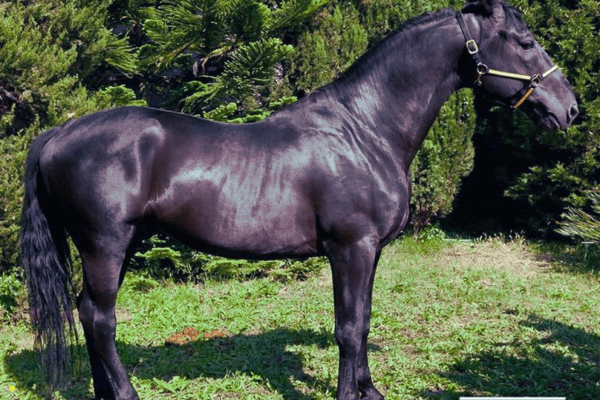The Persano Horse, a breed steeped in historical significance, emerged from the Royal Stud of Persano, intertwined with the Salerno horse lineage. These two distinct yet ancestrally linked breeds epitomize a shared equine legacy. The Persano, meticulously cultivated during the 19th century, was primarily bred for military applications, showcasing its resilience and adaptability. This introduction offers a glimpse into the intriguing journey and attributes of the Persano, a breed that exemplifies equine elegance and strength.
History:
It is the Persano Horse, with its unique history and enigmatic features, is a fascinating part of the world of breeds that are equine. Although this breed isn’t well-known, has an impressive history that weaves into the vast tapestry of Italy’s equine history.
Ancestral Origins:
The Persano Horse has a genetic lineage to the Salerno breed. Both of which trace their ancestors all the way back to Royal Stud of Persano. The common ancestry is a mixture from Oriental, Neapolitan, and Spanish bloodlines, forming an underlying of power and grace.
18th-century Development:
Bred originally to serve purposed for military and for military purposes, the Persano Horse became known for its toughness and agility, which made it a favorite horse for officers of the cavalry. The characteristics of the horse were designed to satisfy the demands of military life, showing its endurance in a variety of types of terrains and conditions.
Historical Significance:
The breed’s prominence is underscored by its use in a significant event during World War II. In August 1942, the Persano horses were part of what is claimed to be the last successful cavalry charge in modern warfare, against Russian infantry near Isbushensky, highlighting their strategic importance in military history.
Royal Establishment and Decline:
King Charles III of the Bourbon dynasty established the breed in 1762, crossbreeding Andalusian Arab stallions with Eastern-origin mares. However, in 1874, the Italian government decided to suppress the breed, leading to the sale of many Persanos at public auction.
20th Century Revival Efforts:
In 1900, a revival effort began by selecting mares that had good riding qualities and temperaments from different military units. They were bred with two renowned horses: ‘Giacobello’ an Arab hybrid and ‘Jubilee’ an English thoroughbred. This was an important effort to preserve the breed.
Post-World War II challenges:
After 1954, which saw the closure of the Center for the Re-introduction and Re-introduction of quadrupeds the number of breeds had drastically diminished, leaving only a handful of breeding mares left. The breed was then moved to the facility located in Grosseto under the ministry of defense’s authority.
Breed characteristics and versatility:
The Persano is a breed that is known for its docility and elegance excels in a variety of disciplines of equestrian. It has demonstrated exceptional ability in the sport of dressage and leisure riding, which demonstrates its ability to adapt and be flexible.
Conservation status:
in the year 2007 the Food and Agricultural Organization of the United Nations classified the Persano breed as critically endangered. This designation highlighted the urgency of conservation efforts to save this rare breed.
Modern Preservation Strategies:
Today, private stables located in Persano are among the stables that Persano region are devoted to preserving the breed. This is about preserving the breed’s purity, encouraging its traits, and ensuring the breed’s survival for generations to enjoy.

Physical Characteristics:
The Persano horse is usually between 15 and 16 hands tall, and displays an impressively proportioned and muscular physique.
They sport an elegant and noble head, with a straight silhouette with large eyes that are expressive, and properly placed ears. The coat colors of these horses vary depending on the breed, but bay grey, chestnut, and bay are the most popular.
They are known for their sturdy legs, well-formed and sturdy hooves, which are perfect for all kinds of terrains.
Temperament and Abilities:
The Persano horses are famous for their ability to think, courage and gentleness, which makes them ideal for a variety of disciplines. They are quick to learn and are receptive to training and possess a calm but lively temperament.
Primarily bred for military use and for military purposes, the Persano horse has great stamina, agility and the capacity to deal with difficult situations. This is why they are ideal for endurance riding as well as other sports requiring a high level of equestrian skill.
Current Status and Usage:
In the present Persano horses are in high demand. Persano horse is a rare breed and is the subject of efforts to protect this rare breed. They are used primarily to ride endurance events, however their versatility makes them ideal for show jumping, dressage and pleasure riding. The breed’s endurance and strength make them ideal for long-distance trail rides as well as endurance competitions.

Cultural significance:
The Persano horse has a unique place in Italian historical equestrian culture. It represents the rich heritage that is Italian horse breeding as well as the development of horse use from the military to recreational and competition disciplines.
Breeders and historians appreciate the Persano because of its significance in history and role in the development of other Italian breeds of horses.
Conservation Initiatives:
Conservation efforts are vital to the Persano horse. The breeding programs and registry offices concentrate on maintaining the purity of the breed as well as promoting its characteristics.
This ensures that the Persano horse will continue to flourish by preserving its unique traits that future generations can enjoy and appreciate.

